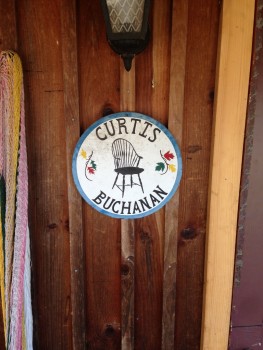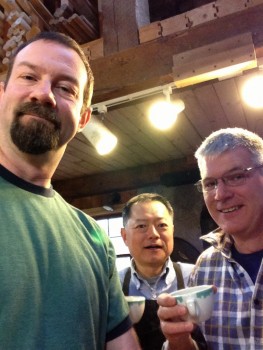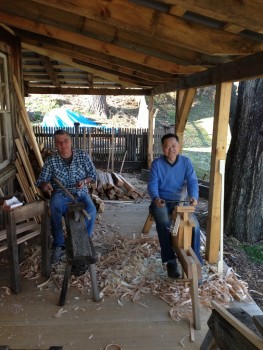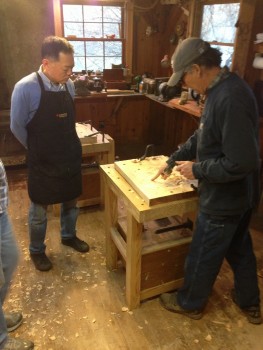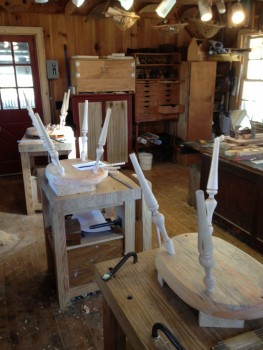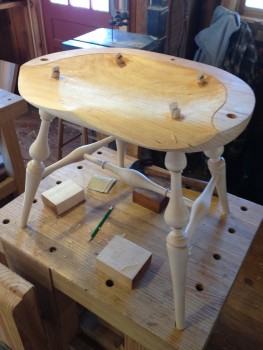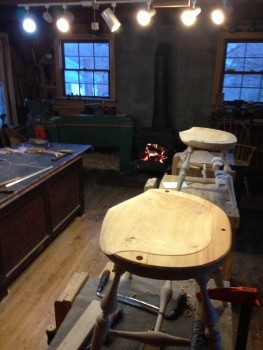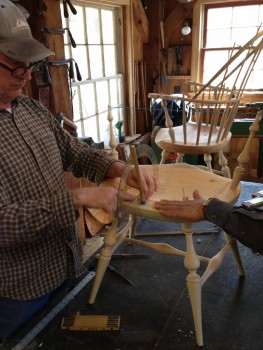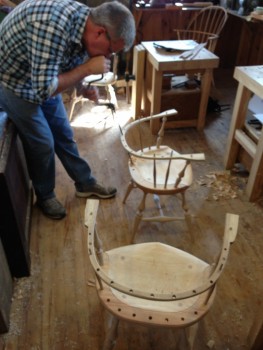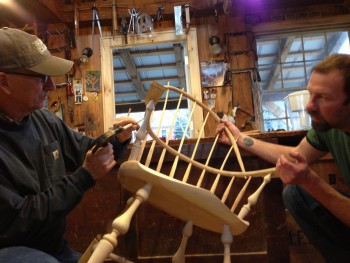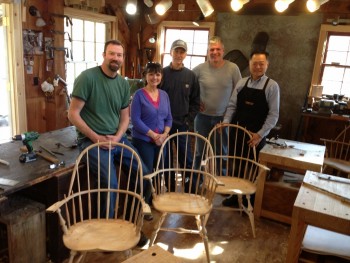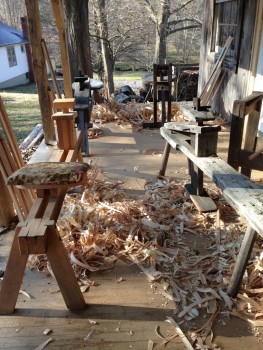In early March of 2014, I loaded some camping gear into my rusty 2003 Kia Spectra and headed south on interstate 81, feeling the wind at my back as I cruised toward the unknown. I was headed to the shop of Curtis Buchanan, a Windsor chair maker in Jonesborough, Tennessee, for a week long chair building class. My mind was brimming with excitement and I felt that I was heading into a vision quest, a grand adventure, a journey of self discovery and new horizons. I had no idea what a dramatic transformation I was in for.
Up until this point, I felt I had a pretty clear idea about the basics of furniture making. You needed electricity, a table saw, band saw, jointer, planer, router, electric drill, and various sanders, at a minimum. Kiln dried boards were essential. A spray booth was really helpful. Hearing protection, eye protection, lung protection, and constant vigilance around the machines-these were also givens. Sharpening skills and hand tools were only part of the equation. This was the path I was on. Little did I know that my week in Tennessee was about to spin me on my head, challenge literally everything I thought I knew about my trade, and open the door to a parallel universe of fine woodcraft that was hiding in plain sight, the evidence all around me, though I could scarcely see it. Indeed, there was another road…
In the year prior to the class, I had bought a stack of used Woodwork magazines, which featured a different woodworker in each issue. I often find the life stories and insights of woodworkers to be as fascinating as the work itself. It’s really all about people and human connection at the core, isn’t it? On the cover of issue #103 from Feb 2007, Curtis is pictured at his shaving horse, curls of oak rolling off the edge of a drawknife. Hmm, what was this all about? His words and the photographs of his chairs hit me like a lightning bolt. Prior to this I had never even really noticed Windsor chairs. Perhaps because we are surrounded, literally, by a sea of poorly made factory Windsor “style” chairs. I suppose I associated the style with cheap, clunky, poorly proportioned factory furniture. I had zero knowledge of this craft. Curtis’s chairs are radically different from anything I had ever encountered. They are lively, delicate, and balanced, with a stance and poise that is unmatched. His turnings are sublime in their crisp flowing lines, and the toolmarks left on shimmering surfaces bear testimony to decades of skill and restraint. Now that I’ve gotten to sit in many of his chairs, I can also attest to their incredible comfort. The photographs of the chairs first drew me in, and then I began to absorb what he was saying about HOW these chairs are made. My eyes opened wide as I realized that this amazing fine furniture is constructed in a fundamentally different way, from start to finish, from anything in my experience. Then I read a line which began “the hardest part for students…” and a light bulb went off. Students?? Maybe I could do this!
I felt that my opportunities for formal woodworking instruction had long passed me by-I had no money for school, I had learned on the job and on my own, and now I just needed to keep on truckin’, try to survive and scratch out a living. But Curtis put me on his wait list, and eventually he let me know that he had an opening. My fiance Michele was so totally supportive-despite the financial obstacles, she basically commanded me to go! And so it was I found myself pulling into the little village of Jonesborough with four bald tires and the check engine light on, eager to learn something new.
Jonesborough is a quaint and friendly little town. I explored main street for a bit and headed a few miles down the road to a local waterpark/campground to set up camp for the week. Being early March, the park was deserted, beautiful and quiet. It suited my contemplative state of mind, and the sense of being on a solo mission into the unknown. Home sweet home for the next seven days.
Class began the next day at 8am, and myself and the other two students arrived and greeted each other in the shop. Curtis and his wife Marilyn made us all feel so welcome. They are easy going, charming and talkative, with a kindness and love of life that radiates outward toward others. Their home and shop are nestled near the center of town, on a small rise overlooking the village. It’s a beautiful spot, and the feeling of walking down through their terraced gardens and stepping foot in the shop for the first time was nothing short of magical. This was unlike any other woodworking environment I had ever experienced. Curtis has a great website, http://www.curtisbuchananchairmaker.com/, and he also has a wonderful slideshow which describes his work and his shop far better than I ever could. http://www.finewoodworking.com/item/114435/curtis-buchanan-windsor-master
I was excited to be learning alongside two others: Steve, from South Korea, and Jamie, from Australia. Three continents represented! Steve was beginning a journey into woodworking later in life, and his zeal for the craft was inspiring. Jamie was returning for his second class with Curtis, and his passion for Windsor chair making was tremendous. We were all thrilled to be there, so with a hot cup of coffee and Curtis to guide us, we dove into the work! We headed outside to examine a white oak log lying in the yard…
I’ll pause here to say that in the almost two years that have passed since that week in Tennessee, I’ve tried to distill in my mind just what it is about Windsor chair making that is so unique and different from other styles of woodwork. Firstly, the entire chair is made with hand tools. More specifically, edge tools. Therefore, sharpening skill is of paramount importance. If one cannot sharpen a drawknife, adze, scorp, travisher, scrapers, planes, chisels, carving gouges, spokeshaves, auger bits, and lathe tools, there is no chance of even beginning to make a chair. Well, at least you don’t have to sharpen your froe! And while most styles of woodworking incorporate some hand tool work, chairmaking is entirely handwork, start to finish. Seriously fun stuff.
So we split some oak and rived it into blanks for arm rails, crests, and spindles, then headed up onto the porch to listen to the chirping of the birds and begin working this fresh green oak. Seated on the shave horse, we began with the drawknife, which brings me to to the second unique and wonderful aspect of chairmaking.
Working green wood in this way brings a person as close to the material as is humanly possible. To say it another way, it lets us understand and connect with the very essence of what that tree is-did it grow fast or slow; on a hill or on flat ground; with a gentle curve or straight and true; is the wood supple and creamy or brash and brittle; are the wood fibers long and even or short and meandering; what is the very nature of this material? All of these questions begin to be answered when we bring a razor sharp drawknife to bear, and start to follow the chairmakers path.
At the tablesaw, we use the fence to guide the cut, and with carbide steel teeth and horsepower, we easily cut wood in a straight line, regardless of how that tree had grown. Conversely, with a rived blank of green wood and the drawknife, we aim to smooth a surface of the wood while following the long wood fibers accurately. The wood itself is our guide. Indeed, one can create a square spindle blank that follows a single growth ring from one end to the other. This yields a blank that is as strong as possible, has no run out and therefore can be worked beautifully in either direction, and will steam bend without failure. It need not be straight-in fact, curved pieces end up being advantageous when assembly begins. Using the drawknife in this way gives one amazing feedback about the material, is meditative and addicting, and just plain fun!
A chair in seven days. It seemed a tall order. Curtis has been teaching a long time, he knows what needs to happen, and we progressed at an easy pace. There was lots of story telling, laughter, and comraderie-the relaxed pace and chance to simply focus and learn to use these tools was a joy. Which brings me to my third point. Joy. Not a concept that always goes along with work. In this case, it most certainly does. The various tasks in chairmaking include: splitting and riving logs, whittling and spokeshaving, planing and carving seats, carving ears and knuckles, drilling and reaming angled holes, turning at the lathe, steambending, gluing and assembling, painting and oiling. All of this work is pleasurable, meditative, and soulful. It all fosters and sustains contentedness, moment to moment, day to day.
Seat carving and arm post fitting. You’ll notice the bandsaw in the backround-Curtis went without one for years, and it only sees use in cutting out the seat, and for various small tasks. It isn’t needed, but it is a small concession to the machine age.
Scorp in hand, Curtis discusses the subtleties of seat carving.
Fitting the understructure. There are many opportunities to correct angles and reach for perfection during the process. Curtis supplies the turned components for the class, as turning is a craft that takes years to master. His turnings, straight off the skew chisel, are as smooth as a baby’s butt. He is a true master.
Early morning in the shop, mid week. I remember this morning vividly. It was cold, and I had slept little, my mind filled with new thoughts. Pancakes and eggs at a little diner in town, the news on tv-a jetliner had vanished…it seemed a million miles from my reality-then off to the shop. I started a fire and soaked up the quiet early dawn calm of the woodshop. With the crackling of the fire and the scent of fresh oak and pine filling my senses, I pondered the vibration of this place. A compact little timber frame, it feels perhaps more like a church than a shop-a place where things can still make sense, where one can be at ones best, a place to create that is close to nature and pure in its focus. A fine shop indeed. We were halfway through the week, and I wished it wouldn’t have to end. This craft had me deeply hooked already; I was changing and I could feel it. Soon the others would arrive and another day of stories, laughter and chair building would begin.
Curtis reads the angle for the center spindle-everything emanates from the plane of the seat. Balance and symmetry are the goals-if it looks good, it is good. A harmony of good proportion, comfort, strong tight joinery, and crisp tool marks blend to create a fine chair.
Jamie drills for the long spindles. This stuff is seriously, seriously fun. Drilling with auger bit and brace is not merely quaint-it creates a crisp clean hole, allows a predictable depth by counting turns, and is quiet and calm which encourages focus. And it’s fun-did I mention that? There are also times where the electric drill is very useful, but for the most part I prefer the brace. Below, Curtis taps a wedge into the back bow, as the chair finally comes together.
By the end of the week, we all had made fine chairs, and had opened the door to a new way of working wood. Curtis’s teaching style is so relaxed and generous, his knowledge deep and nuanced, and his stories captivating and witty. I was continually struck by the feeling of connectedness I sensed between him, his tools, and the wood. Like a virtuoso musician, an Olympic athlete, or a brilliant chef, he works with a fluid, calm certainty that needs to be experienced firsthand to be truly understood. I suspect that one reason he finds himself at this place of mastery is because of the contentedness that this work imparts upon a person. Curtis would often say that “contentedness is underrated.” This was further evidenced in the life he and his family have built. He and Marilyn are an incredible team, and they’ve opened their home and their lives to students who hail from around the globe. Harmony with nature, hard work and creativity, and connection to people-these are the lessons I learned in Jonesborough. I came away with new friends, bonded by a common interest in craft and connection to nature, as well as a new respect not just for making a living, but for making a life.
My steadfast Kia got me home, and I quickly built a shave horse, lightbulb kiln, steambox, and seat carving bench. I purchased a 1940’s lathe, and began acquiring chair making tools. I’ve since built a handful of Windsors and have several original designs in progress. Chair making skills have also informed other aspects of my woodworking-a steam bent spindled crest found its way on top of a bakers rack, and tapered tenons are used to join legs on various pieces. I’ve no doubt that I will continue to grow into chair making, even as I work wood with other methods. The craft has got a hold of me, and I am captivated. To the woodworker who has not yet delved into green wood, I would offer strong encouragement-you may unlock a world that you didn’t even know existed, replete with birdsong and happiness.


